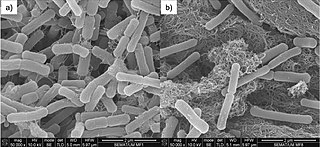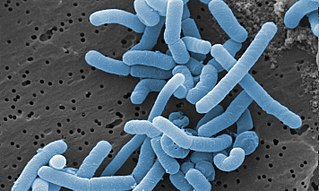Related Research Articles

Pseudomonadota is a major phylum of Gram-negative bacteria. Currently, they are considered the predominant phylum within the realm of bacteria. They are naturally found as pathogenic and free-living (non-parasitic) genera. The phylum comprises six classes Acidithiobacillia, Alphaproteobacteria, Betaproteobacteria, Gammaproteobacteria, Hydrogenophilia, and Zetaproteobacteria. The Pseudomonadota are widely diverse, with differences in morphology, metabolic processes, relevance to humans, and ecological influence.

The phylum Bacteroidota is composed of three large classes of Gram-negative, nonsporeforming, anaerobic or aerobic, and rod-shaped bacteria that are widely distributed in the environment, including in soil, sediments, and sea water, as well as in the guts and on the skin of animals.

Bacteroides is a genus of Gram-negative, obligate anaerobic bacteria. Bacteroides species are non endospore-forming bacilli, and may be either motile or nonmotile, depending on the species. The DNA base composition is 40–48% GC. Unusual in bacterial organisms, Bacteroides membranes contain sphingolipids. They also contain meso-diaminopimelic acid in their peptidoglycan layer.

Bacteroides fragilis is an anaerobic, Gram-negative, pleomorphic to rod-shaped bacterium. It is part of the normal microbiota of the human colon and is generally commensal, but can cause infection if displaced into the bloodstream or surrounding tissue following surgery, disease, or trauma.

Methanobacterium is a genus of the Methanobacteria class in the Archaea kingdom, which produce methane as a metabolic byproduct. Despite the name, this genus belongs not to the bacterial domain but the archaeal domain. Methanobacterium are nonmotile and live without oxygen, which is toxic to them, and they only inhabit anoxic environments.
Piromyces is a genus of fungi in the family Neocallimastigaceae.
Lentisphaerota is a phylum of bacteria closely related to Chlamydiota and Verrucomicrobiota.
Armatimonas rosea is a Gram-negative bacterium and also the first species to be characterized within the phylum Armatimonadota. The Armatimonadota were previously known as candidate phylum OP10. OP10 was composed solely of environmental 16S rRNA gene clone sequences prior to A. rosea's discovery.

Lacticaseibacillus paracasei (commonly abbreviated as Lc. paracasei) is a gram-positive, homofermentative species of lactic acid bacteria that are commonly used in dairy product fermentation and as probiotic cultures. Lc. paracasei is a bacterium that operates by commensalism. It is commonly found in many human habitats such as human intestinal tracts and mouths as well as sewages, silages, and previously mentioned dairy products. The name includes morphology, a rod-shaped bacterium with a width of 2.0 to 4.0μm and length of 0.8 to 1.0μm.
The altered Schaedler flora (ASF) is a community of eight bacterial species: two lactobacilli, one Bacteroides, one spiral bacterium of the Flexistipes genus, and four extremely oxygen sensitive (EOS) fusiform-shaped species. The bacteria are selected for their dominance and persistence in the normal microflora of mice, and for their ability to be isolated and grown in laboratory settings. Germ-free animals, mainly mice, are colonized with ASF for the purpose of studying the gastrointestinal (GI) tract. Intestinal mutualistic bacteria play an important role in affecting gene expression of the GI tract, immune responses, nutrient absorption, and pathogen resistance. The standardized microbial cocktail enabled the controlled study of microbe and host interactions, role of microbes, pathogen effects, and intestinal immunity and disease association, such as cancer, inflammatory bowel disease, diabetes, and other inflammatory or autoimmune diseases. Also, compared to germfree animals, ASF mice have fully developed immune system, resistance to opportunistic pathogens, and normal GI function and health, and are a great representation of normal mice.
Syntrophococcus sucromutans is a Gram-negative strictly anaerobic chemoorganotrophic Bacillota. These bacteria can be found forming small chains in the habitat where it was first isolated, the rumen of cows. It is the type strain of genus Syntrophococcus and it has an uncommon one-carbon metabolic pathway, forming acetate from formate as a product of sugar oxidation.
Oscillibacter valericigenes is a species of mesophilic bacterium identified in the alimentary canal of Japanese Corbicula clams. It is Gram-negative and anaerobic, with a straight to slightly curved rod-like morphology, and is motile with petritrichous flagella. It was not observed in culture to form spores.
Lentisphera araneosa is a marine bacteria strain in the bacterial phylum Lentisphaerota. They are able to produce viscous transparent exopolymers and grow attached to each other by the polymer in a three-dimensional configuration. They are part of the natural surface bacterial population in the Atlantic and Pacific oceans. They are less than 1% of the total bacterial community. This species is gram negative, non-motile, non-pigmented, aerobic, chemoheterotrophic, and facultatively oligotrophic sphere-shaped. Its genome has been sequenced.
In microbiology, the term isolation refers to the separation of a strain from a natural, mixed population of living microbes, as present in the environment, for example in water or soil, or from living beings with skin flora, oral flora or gut flora, in order to identify the microbe(s) of interest. Historically, the laboratory techniques of isolation first developed in the field of bacteriology and parasitology, before those in virology during the 20th century.
Christensenella is a genus of non-spore-forming, anaerobic, and nonmotile bacteria from the family Christensenellaceae. They are also part of the order Clostridiales, the class Clostridia and the phylum Firmicutes. Phylogenetic analyzes of 16S rRNA gene sequences are used to describe this family. Due to the recent discovery of the Christensenellaceae family, it was not given importance until a few years ago. This is why very little is known about its ecology and how it may be associated with host factors and other microbiota. However, recent studies establish that members of this family, with exceptions, may be associated with a healthy phenotype for humans. The species C. minuta has been published and validated, and C. timonensis and C. massiliensis have been proposed as novel species of the genus Christensenella, all isolated from human feces.
Anaerococcus is a genus of bacteria. Its type species is Anaerococcus prevotii. These bacteria are Gram-positive and strictly anaerobic. The genus Anaerococcus was proposed in 2001. Its genome was sequenced in August 2009. The genus Anaerococcus is one of six genera classified within the group GPAC. These six genera are found in the human body as part of the commensal human microbiota.
Cetobacterium somerae is a microaerotolerant, Gram-negative, and rod-shaped anaerobic bacteria found in the gastrointestinal tract of fish living in freshwater ecosystems. The bacteria is also immobile and non-spore forming. C. somerae was first isolated from the feces of children with Autism spectrum disorder. Members of bacteria within the Cetobacterium genus tend to dominate the microbiota of fish in freshwater ecosystems. Cetobacterium somerae also produces vitamin B-12 within the gastrointestinal tract of fish in order to provide nutritional support for growth.
TM7x, also known as Nanosynbacter lyticus type strain TM7x HMT 952. is a phylotype of one of the most enigmatic phyla, Candidatus Saccharibacteria, formerly candidate phylum TM7. It is the only member of the candidate phylum that has been cultivated successfully from the human oral cavity, and stably maintained in vitro. and serves as a crucial paradigm. of the newly described Candidate Phyla Radiation (CPR). The cultivated oral taxon is designated as Saccharibacteria oral taxon TM7x. TM7x has a unique lifestyle in comparison to other bacteria that are associated with humans. It is an obligate epibiont parasite, or an "epiparasite", growing on the surface of its host bacterial species Actinomyces odontolyticus subspecies actinosynbacter strain XH001, which is referred to as the "basibiont". Actinomyces species are one of the early microbial colonizers in the oral cavity. Together, they exhibit parasitic epibiont symbiosis.
Christensenella hongkongensis is a species of clinically relevant gram-positive coccobacilli, first isolated from patients in Hong Kong and Canada in 2006. Although the species remains relatively rare, it has a high mortality rate of up to 50%. Christensenella is thought to be broadly distributed globally, as it has been isolated from patient blood cultures around the world including Hong Kong, South Korea, New Zealand, Canada, Sweden, France and Italy. Fewer than 15 cases of C. hongkongensis have been observed worldwide.
Oxalobacter aliiformigenes is a Gram negative, non-spore-forming, oxalate-degrading anaerobic bacterium that was first isolated from human fecal samples. O. aliiformigenes consumes oxalate as its main carbon source but is negative for indole production and negative for sulfate and nitrate reduction. Cells appear rod shaped, though occasionally present as curved, and do not possess flagella.
References
- 1 2 van Passel, Mark (11 March 2011). "Genome Sequence of Victivallis vadensis ATCC BAA-548, an Anaerobic Bacterium from the Phylum Lentisphaerae, Isolated from the Human Gastrointestinal Tract". Journal of Bacteriology. 193 (9): 2373–2374. doi:10.1128/JB.00271-11. PMC 3133096 . PMID 21398537.
- 1 2 3 4 5 6 7 8 9 10 Zoetendal, Erwin G. (2003). "Victivallis vadensis gen. nov., sp. nov., a sugar-fermenting anaerobe from human faeces". International Journal of Systematic and Evolutionary Microbiology. 53 (1): 211–215. doi: 10.1099/ijs.0.02362-0 . PMID 12656175.
- ↑ Guarner, Francisco (8 Feb 2003). "Gut flora in health and disease". The Lancet. 361 (9356): 512–519. doi:10.1016/S0140-6736(03)12489-0. PMID 12583961. S2CID 38767655 . Retrieved 11 Nov 2014.
- 1 2 3 4 5 6 7 8 Cho, Jang-Cheon (2011). Bergey's Manual of Systematic Bacteriology (2 ed.). New York: Springer Verlag. pp. 13, 785–793. ISBN 978-0-387-68572-4.
- 1 2 Cho, Jang-Cheon (2004). "Lentisphaera araneosa gen. nov., sp. nov, a transparent exopolymer producing marine bacterium, and the description of a novel bacterial phylum, Lentisphaerae". Environmental Microbiology. 6 (6): 611–621. Bibcode:2004EnvMi...6..611C. doi:10.1111/j.1462-2920.2004.00614.x. PMID 15142250.